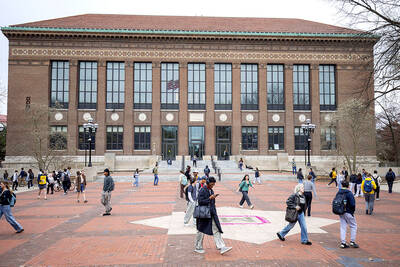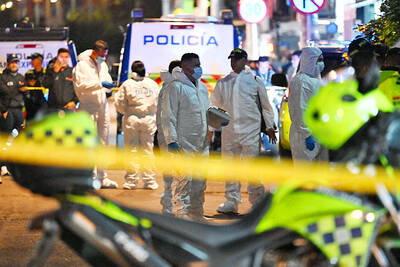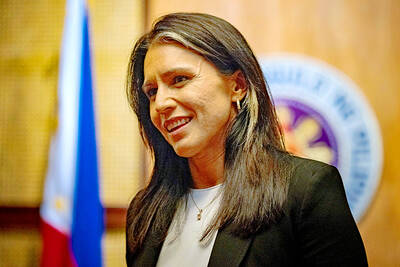The call to prayer from the minaret reaches out over tightly packed alleys in a Ho Chi Minh City neighborhood as men in white knitted skullcaps and colorful sarongs walk to their local mosque.
The scene is more reminiscent of Malaysia, Indonesia or Brunei — not Vietnam.
This small community in an area known as District 8 says it is the largest enclave of Cham Muslims in the metropolis informally still known as Saigon. It has more than 1,300 residents, halal restaurants, a large mosque and a madrasah that regularly sends students to Malaysia for further study.

PHOTO: AFP
These and other Cham communities in southern and central Vietnam are all that remain of the Champa kingdom that ruled for centuries.
There are more than 100,000 Chams in the country of 86 million, the government says.
“The Cham fell and lost their country. I feel like I live in another country and it’s not my home,” says a 49-year-old noodle-seller who gave her name only as Hachot.
The Cham were a Hindu people who ruled parts of south and central Vietnam for hundreds of years and gradually converted to Islam. By the late 15th century, the Vietnamese had pushed south and Champa was in decline. Today, the kingdom’s most visible legacy is the My Son temple ruin near Danang. It is a UNESCO world heritage site and popular with tourists.
These days more than 80 percent of Cham are adherents of Islam, researchers say.
Government data show Muslims are the smallest of six major religious groups in the country, with Buddhism the largest.
Religious activity remains under state control, but worship among a variety of faiths is flourishing. However, Catholics have had a long-running dispute with the government over land, and some minority Buddhist groups have complained of persecution.
The Muslims have kept a lower profile.
“We just follow this religion. We don’t care about politics,” says Haji Mou-sa, 52, deputy manager of the local madrasah.
He is fluent in Malay and knows some Arabic.
Mou-sa says Ho Chi Minh City has more than a dozen imams, all trained in Vietnam. Foreign imams also visit, especially from Malaysia, and the Koran has been translated into Vietnamese.
A slight man in a collarless shirt, sarong and metal-rimmed glasses, he has lived in District 8 since the 1960s, when Chams first began moving to the area. Many came from the Mekong Delta province of An Giang, where Chau Doc city is still home to a significant Cham Muslim population.
In the beginning, the District 8 Cham homes were made from wood and thatch. Electricity came to the area in 1990, and much later a bridge was built connecting the once-isolated area to downtown, leading to rapid development of the surrounding area. According to residents, there are 16 mosques in Ho Chi Minh City, some of them built with assistance from Muslim nations. A plaque in the Cham neighborhood’s Masjid Jamiul Anwar says it was rebuilt in 2006 with funds from the United Arab Emirates and the Red Crescent.
Although they get support from the Middle East, Cham relations remain strongest with Malaysia and Indonesia, thanks partly to shared cultural and religious values. “Malaysians came here and supported schools and better jobs,” Hachot said.
The ties started more than 20 years ago after Vietnam began a policy of gradual economic openness.
She says she does not feel a part of wider Vietnamese society, even though the government helped to rebuild her house some years ago.
Attitudes of the majority Kinh ethnic group towards the Cham vary, Hachot said.
“Some Kinh say the Cham are dirty,” she said, and they object to the Muslims’ shunning of pork. “Other people don’t care.”
Many older Muslim residents make pilgrimages to Mecca, and most Cham have Arabic names on their government-issued identity cards. Mohamath Zukry, 22, moved from his small town in An Giang more than 18 months ago to study and live at the madrasah. He plans to go to Malaysia to finish his religious education, and to study information technology.
Less devout Mack Aly, 29, a real estate agent who lives outside the Cham neighborhood, says he still enjoys an alcoholic drink with his friends, and dates a non-Muslim woman.
“In Vietnam religion is not so strong. I won’t eat pork, but I don’t pray five times a day. And I drink and smoke,” he said at an upscale coffee shop.

A Chinese scientist was arrested while arriving in the US at Detroit airport, the second case in days involving the alleged smuggling of biological material, authorities said on Monday. The scientist is accused of shipping biological material months ago to staff at a laboratory at the University of Michigan. The FBI, in a court filing, described it as material related to certain worms and requires a government permit. “The guidelines for importing biological materials into the US for research purposes are stringent, but clear, and actions like this undermine the legitimate work of other visiting scholars,” said John Nowak, who leads field

Swedish campaigner Greta Thunberg was deported from Israel yesterday, the Israeli Ministry of Foreign Affairs said, the day after the Israeli navy prevented her and a group of fellow pro-Palestinian activists from sailing to Gaza. Thunberg, 22, was put on a flight to France, the ministry said, adding that she would travel on to Sweden from there. Three other people who had been aboard the charity vessel also agreed to immediate repatriation. Eight other crew members are contesting their deportation order, Israeli rights group Adalah, which advised them, said in a statement. They are being held at a detention center ahead of a

‘THE RED LINE’: Colombian President Gustavo Petro promised a thorough probe into the attack on the senator, who had announced his presidential bid in March Colombian Senator Miguel Uribe Turbay, a possible candidate in the country’s presidential election next year, was shot and wounded at a campaign rally in Bogota on Saturday, authorities said. His conservative Democratic Center party released a statement calling it “an unacceptable act of violence.” The attack took place in a park in the Fontibon neighborhood when armed assailants shot him from behind, said the right-wing Democratic Center, which was the party of former Colombian president Alvaro Uribe. The men are not related. Images circulating on social media showed Uribe Turbay, 39, covered in blood being held by several people. The Santa Fe Foundation

NUCLEAR WARNING: Elites are carelessly fomenting fear and tensions between nuclear powers, perhaps because they have access to shelters, Tulsi Gabbard said After a trip to Hiroshima, US Director of National Intelligence Tulsi Gabbard on Tuesday warned that “warmongers” were pushing the world to the brink of nuclear war. Gabbard did not specify her concerns. Gabbard posted on social media a video of grisly footage from the world’s first nuclear attack and of her staring reflectively at the Hiroshima Peace Memorial. On Aug. 6, 1945, the US obliterated Hiroshima, killing 140,000 people in the explosion and by the end of the year from the uranium bomb’s effects. Three days later, a US plane dropped a plutonium bomb on Nagasaki, leaving abut 74,000 people dead by the